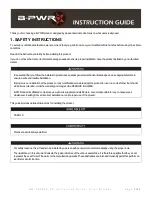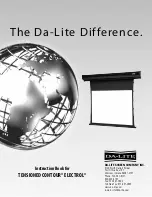
Heinrichs Messtechnik GmbH
Page 14 of 20
EX-Supplementary Operating Manual
HPC Mass Flow Meter
operator is to ensure that in the area of these tubes, no risk of damage through the medium or
mechanical assertion shall occur.
i)
Seized screws or adhering joints (e.g. by frost or corrosion) are not to be opened with force in the
presence of a potentially explosive atmosphere.
j)
Where substances of explosion group “A” or “IIC” are present and the presence of an Ex-atmosphere
is considered possible, only non-sparking tools shall be used.
k)
The sensors loop hood may be produced from Aluminium alloy. In rare cases, ignition sources due to
impact and friction sparks could occur. This shall be considered during installation particularly if the
equipment is installed in a zone 0 location.
The danger of objects falling onto the sensor shall be excluded.
l)
Combination of the external barriers from the transmitter has not been assessed. Therefore, each
input wiring circuit to the sensors should be kept segregated from the other inputs as per
requirements of the standards.
m)
For the high temperature version, the temperature class, assigned maximum surface temperature,
maximum ambient temperature and Equipment Protection Level (EPL) are dependent on the
maximum process temperature applied by the end-user/installer. The options are detailed under the
description in the certificate. When the maximum process temperature of the final installation is
determined by the end user, the temperature class, assigned maximum surface temperature,
maximum ambient temperature and the Equipment Protection Level (EPL) which are applicable to the
applied process temperature shall be observed and complied with.
The equipment is marked with the maximum ambient temperature and maximum process
temperature with all options stated in the certificate, but the limits may be lower than those marked
depending on the actual process temperature applied.
5.4
Requirements for installation dust environments
a)
It is to be ensured that the sensor complies with the requirements of the degree of protection of at
least IP54 (cable glands and conduits) and gaskets must be protected against adverse environmental
conditions.
b)
In certain extreme circumstances, the non-metallic parts incorporated in the enclosure of the sensor
may generate an ignition-capable level of electrostatic charge. Therefore, the user/installer shall
implement precautions to prevent the build-up of electrostatic charge, e.g. locate the equipment
where a charge-generating mechanism (such as wind-blown dust) is unlikely to be present. Clean
regularly with a damp cloth.
c)
The sensors are to be electro-statically earthed. Electrostatic charging must be avoided.
5.5
Ex relevant screw and bolt torques
There are no relevant torques to be observed.





































